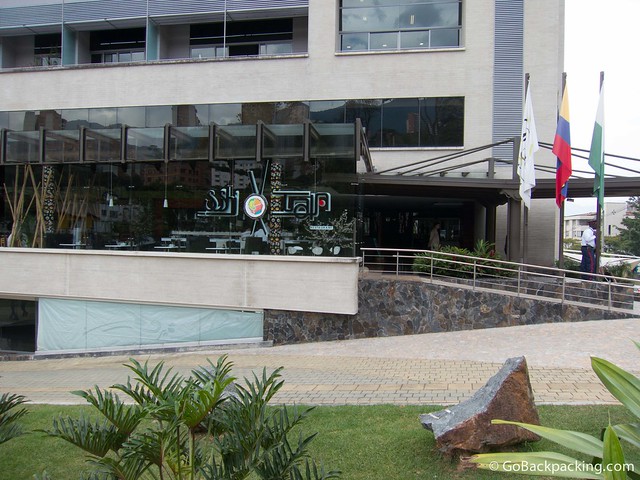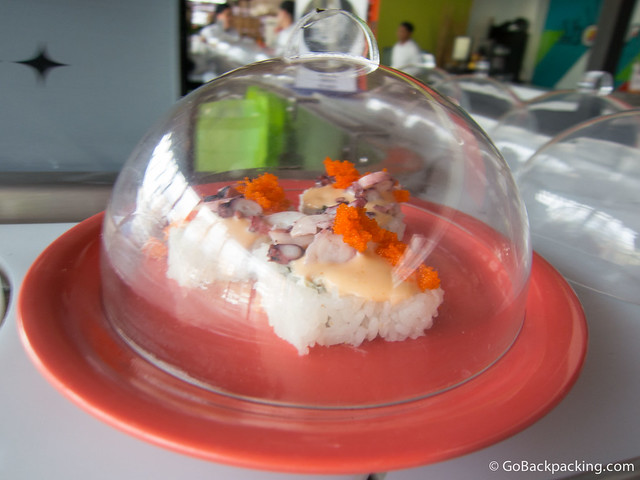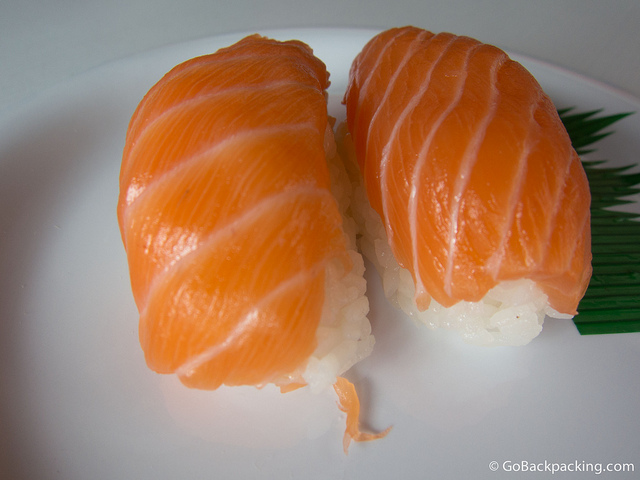
When my paisa friend mentioned in passing that Sushi Train is known for serving up the best sushi in Medellin, I bumped the restaurant to the top of my dining list.
I’d noticed it on the ground floor of the Diez Hotel in Poblado before, but never had the occasion to go in.
The truth is I’ve made such a habit out of going to Sushi Light on Tuesdays, that I hadn’t been bothering to try anywhere else.
To remedy this unhealthy dependence, I stopped into Sushi Train last Friday afternoon, around 2 PM, for lunch. I had the place to myself.
Sushi Train’s busiest service is Friday nights, which I’m guessing, is the after-work crowd, a portion of which are staying at the hotel. Saturday nights, according to my waiter, are not as busy.

Half of the seating at Sushi Train is around the conveyor belt, which presents a parade of sushi and nigiri dishes. To my knowledge, it’s the only one in town.
If you haven’t eaten sushi from a conveyor belt before, it’s a lot of fun, and much faster than ordering from the menu.
Each of the plates is color coded to correspond with a certain price. At Sushi Train, the prices ranged from 5,500 to 7,500 pesos ($3 – $4) per plate.
As you eat, you stack up the plates, and then when you’re ready to pay your bill, the waiter takes them away and rings you up based on the number of each color plates, not the specific food you ate.

The first dishes I took off the belt were salmon nigiri, my favorite. They were on a white plate, which equated to 6,000 pesos ($3.38).
The regular menu price for the exact same thing is 8,500 pesos ($4.79).
That’s what you’d have to pay if you chose to sit in one of the booths and order from the menu, versus sitting at the conveyor belt.
It might not sound like much, but if you want 10 pieces of nigiri, you’ll save yourself $7 simply by sitting at the belt.
As you can see in the photo above, the salmon looks fresh, and beautiful. It tasted perfect too. My only complaint is that the chef used A LOT of rice for each piece. A little too much for my taste, as it overwhelmed the fish.
In Japan, I picked up the habit of eating nigiri with my hands.
When my waiter noticed me doing this at Sushi Train, he thought I didn’t know how to use chopsticks, and brought me over a little plastic doohickey to connect them together (like training wheels for those who have trouble using them).
It was a nice gesture.

After gobbling down a few plates of nigiri, I went for a green dish, priced at 5,800 pesos ($3.27).
It had three pieces of sushi, which included salmon, crab sticks, avocado and cheese. When I asked the chef which roll it was on the menu, he said it wasn’t on there.
Another benefit to eating from the conveyor belt is that the sushi chef will put up things that aren’t on the regular menu.
Speaking of the menu, it’s in both Spanish and English, so foreigners are less likely to be confused. I prefer this approach to Sushi Light, which has separate Spanish and English menus.

I’m not the most adventurous when it comes to sushi. Dishes such as octopus, and some I couldn’t identify went around and around, but I kept grabbing the salmon nigiri and the roll with salmon and avocado.
Because it was absolutely dead in there, the selection wasn’t too big at the time, and I didn’t ask for anything in particular.
I’ll be going back for sure, not just to try more food of the conveyor belt, but to order some of the rolls on the menu, priced between 16,000 and 25,000 pesos ($9 – $14).













Funny that the waiter thought you didn’t know how to use chopsticks and offered you the kid chopsticks to use. What did he say when you explained that is the proper way to eat sushi because in Japan that’s how they roll?
I didn’t mention Japan, just that I prefer to eat the nigiri with my hands because the pieces are bigger 🙂
Mmmm…This looks like a great place! I wasn’t fond of fish when I was younger, but my husband has always been a big fan! He’s the one that taught me how to use chopsticks. The smaller bites are the ones that are still harder for me to pick up.
Sophia Liam | http://www.pinkrice.com.au/pinkrice/Restaurant_Home-Sushi_Train.htm